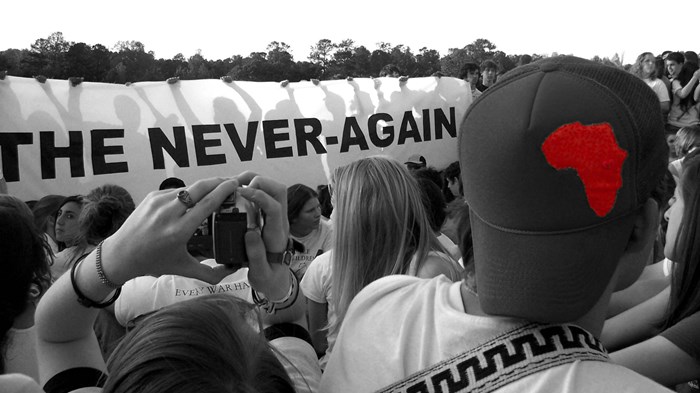
Before the "Ice Bucket Challenge" and "Gangnam Style," there was "Kony 2012." The controversial campaign targeting Joseph Kony, the leader of the Lord's Resistance Army (LRA) which has long plagued Uganda, remains an advocacy game-changer and a virality record holder. But the organization behind it, Invisible Children, will significantly downsize this month and likely shutter most operations by end of 2015.
“It’s the end of Invisible Children as most people know it,” CEO Ben Keesey told BuzzFeed News in a phone interview this weekend. He also explains the changes to GOOD magazine and via Nicholas Kristof's column today for The New York Times.
In 2015, the organization will operate in the US only through political advocacy, lobbying Congressional support for ongoing anti-LRA investments, and will halt the short film productions and events it had become known for, Keesey said. The organization plans to transition its Africa programs to local communities over the coming year.
Invisible Children started small in 2004 with a traveling campaign to show a video shot by founder Jason Russell and two friends in Uganda about the atrocities committed by Kony’s LRA. (In 2006, CT reported on why Ugandan children were killing each other in the name of the Lord.)
But after netting about $12 million from the “Kony 2012” campaign, Invisible Children stopped fundraising and focused on investing in Africa, Keesey told GOOD. When the funds got low, raising them again was virtually impossible. “We’ve done everything we can,” he said.
“Our prayers go out to Invisible Children,” International Justice Mission tweeted Monday morning, calling the group a “premiere justice org.”
While the organization is not Christian—The Atlantic noted that the filmmakers “believe in Christ, but do not want to segregate themselves”—it has roots in the Emergent Church, and founder Russell talked about his Christian mission at schools around the country.
“It was too delicate of a choice to put the cross on our website, or to put a fish on the website,” Russell said in a 2010 Relevant Magazine podcast, “because, you're honestly dealing with the truth.”
Invisible Children saw enormous success with Kony 2012, an Internet campaign centered around a 30-minute YouTube video that garnered more than 100 million views in its first six days and “set a new bar for all things viral” according to Time. Its annual revenue skyrocketed from $8 million to $13 million in the years before the video to $28 million in 2012, reports Fast Company.
Shortly afterward, Russell gained notoriety for a run-in with San Diego police, who found him allegedly naked and ranting on a sidewalk near Pacific Beach. Religion News Service reported his attempt at a comeback. (CT discussed what his mental breakdown shows us about ourselves.)
The video also garnered criticism over its approach to social justice. After it went viral, CT discussed why Kony 2012 was trending and how to best tell other people’s stories as advocacy leaders and political scientists debated the film’s value. More than two years later, opinions are still divided on its true impact, the Washington Post reports.
Responding to similar criticism in 2010, Russell argued that there’s value in “trendy” social justice. “There’s a lot of other things that could be trendy that aren’t as important as global justice or social justice,” Russell told Relevant. “In the grand scheme of things, how amazing is it that even if it is a fad or a trend, at least it’s cool to help other people?”
Fast Companynoted that “in a world where the next ice bucket challenge is a tweet away, how the organization handled the rush of cash, rode a wave of criticism, and dealt with the subsequent attention vacuum can be a lesson to every organization hoping for its own viral hit.”
Invisible Children could have spent their Kony 2012 millions differently to maintain US operations longer, the organization notes on its website. “But our mission has always been to end LRA violence. Therefore, we have and will continue to strive to operate in a way that best serves the communities affected by the LRA, prioritizing investments into the programs that most effectively bring us closer to that goal.”
Since Invisible Children started, the LRA’s fighting force has been reduced by 75 percent, LRA-related killings are down 92 percent, and the US has dedicated more than $200 million to ending LRA violence through Invisible Children-supported policies, the organization states on its website. In addition, Invisible Children has invested more than $65 million directly to U.S. and Africa programs.
“The paradox of running a nonprofit is that the closer you get to achieving your mission, the closer you get to putting yourself out of a job,” Keesey wrote on Kristof's NYT blog.
“We are heavy-hearted because we hoped that all of our programs, both stateside and in Africa, would continue until the day that the LRA was completely dismantled and Joseph Kony was captured,” the organization’s website states. “But we are also incredibly proud of what we have been able to achieve together.”
CT has previously reported on the Lord’s Resistance Army, Africa, and technology.
[Photo courtesy of Lauren Manning - Flickr]

Support Our Work
Subscribe to CT for less than $4.25/month

















